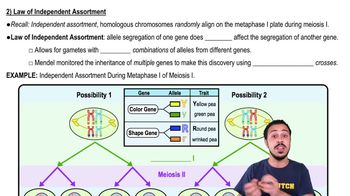13. Mendelian Genetics
Mendel's Laws
Learn with other creators
Practice this topic
- Multiple Choice
Mendel's observation of the segregation of alleles in gamete formation has its basis in which of the following phases of cell division?
5276views33rank1comments - Multiple Choice
Mendel's law of independent assortment has its basis in which of the following events of meiosis I?
6357views30rank1comments - Multiple ChoiceThe law of independent assortment __________.1537views1comments
- Multiple ChoiceIf the two traits that Mendel looked at in his dihybrid cross of smooth yellow peas with wrinkled green peas had been controlled by genes that were located near each other on the same chromosome, then the F2 generation __________.1453views1rank
- Textbook Question
The genes for the traits that Mendel worked with are either all located on different chromosomes or behave as if they were. How did this help Mendel recognize the principle of independent assortment?
a. Otherwise, his dihybrid crosses would not have produced a 9 : 3 : 3 : 1 ratio of F2 phenotypes.
b. The occurrence of individuals with unexpected phenotypes led him to the discovery of recombination.
c. It led him to the realization that the behavior of chromosomes during meiosis explained his results.
d. It meant that the alleles involved were either dominant or recessive, which gave 3 : 1 ratios in the F1 generation.
1182views - Textbook Question
Suppose you are heterozygous for two genes that are located on different chromosomes. You carry alleles A and a for one gene and alleles B and b for the other. Be sure to list all the genetically different gametes that could form and indicate how frequently each type should be observed.
827views - Textbook Question
Suppose you are heterozygous for two genes that are located on different chromosomes. You carry alleles A and a for one gene and alleles B and b for the other. On the diagram, identify the events responsible for the principle of segregation and the principle of independent assortment.
816views - Textbook QuestionSuppose you are heterozygous for two genes that are located on different chromosomes. You carry alleles A and a for one gene and alleles B and b for the other. Label the stages of meiosis, the homologous chromosomes, sister chromatids, nonhomologous chromosomes, genes, and alleles.1133views










